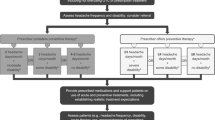Opinion statement
Migraine is a common, chronic neurologic disorder that affects approximately 12% of the adult population in Western countries. Once migraine is diagnosed, illness severity must be assessed. Clinicians and patients should then work together to develop a treatment plan based on patient needs and preferences. The goals of treatment usually include reducing the intensity and duration of acute attacks, minimizing the frequency of attacks, minimizing headache-related disability and maximizing health-related quality of life, and avoiding headache escalation and medication misuse. Management of migraine is divided into pharmacologic and nonpharmacologic approaches. Pharmacologic approaches are subdivided into preventive treatment, taken on a daily basis whether or not headache is present, and acute drugs taken to treat individual attacks as they arise. Acute treatments are further divided into nonspecific agents, which work for all types of pain, and migraine-specific treatments. The US Headache Consortium Guidelines recommend stratified care based on the level of disability to help physicians individualize treatment. Using this approach means that simple analgesics are appropriate as first-line acute treatments for less-disabled patients; if simple analgesics are unsuccessful, treatment is escalated for high-end therapies (eg, triptans). For those with high disability levels, migraine-specific acute therapies, such as the triptans, are recommended as the initial treatment, with preventive drugs in selected patients. A variety of behavioral interventions are helpful. The clinician has an armamentarium of ever-expanding variety of medications. With experience, clinicians can match individual patient needs with the specific characteristics of a drug to optimize therapeutic benefit.
Similar content being viewed by others
References and Recommended Reading
Scher AI, Stewart WF, Lipton RB: Migraine and headache: a meta-analytic approach. In Epidemiology of Pain. Edited by Crombie IK. Seattle: IASP Press; 1999:159–170.
Lipton RB, Stewart WF, Simon D: Medical consultation for migraine: results from the American Migraine Study. Headache 1998, 38:87–96.
Stewart WF, Shechter A, Lipton RB: Migraine heterogeneity: disability, pain intensity, and attack frequency and duration. Neurology 1994, 44(suppl):24–39.
Richard A, Massiou H, Herrmann MA: Frequency and profile of migraine patients seen by general practitioners. Semin Hosp Paris 1999, 75:440–446.
Edmeads J, Lainez JM, Brandes JL, et al.: Potential of the Migraine Disability Assessment (MIDAS) Questionnaire as a public health initiative and in clinical practice. Neurology 2001, 56 (suppl):29–34.
Lipton RB, Diamond S, Reed M, et al.: Migraine diagnosis and treatment: results from the American Migraine Study II. Headache 2001, 41:638–645.
Lipton RB, Stewart WF, Simon D: Medical consultation for migraine: results from the American Migraine Study. Headache 1998, 38:87–96.
Headache Classification Committee of the International Headache Society: Classification and diagnostic criteria for headache disorders, cranial neuralgias and facial pain. Cephalalgia 1988, 8(suppl):1–96.
Goadsby PJ, Lipton RB, Ferrari MD: Migraine: current understanding and treatment. N Engl J Med 2002, 346:257–270. This is an important review of the current treatments for migraine.
Goadsby PJ, Olesen J: Diagnosis and management of migraine. BMJ 1996, 312:1279–1288.
Lipton RB, Stewart WF, Cady R, et al.: 2000 Wolfe Award: sumatriptan for the range of headaches in migraine sufferers: results of the Spectrum study. Headache 2000, 40:783–791.
Tfelt-Hansen P, Olesen J: Effervescent metoclopramide and aspirin versus effervescent aspirin or placebo for migraine attacks: a double-blind study. Cephalalgia 1984, 4:107–111.
Report of the Quality Standards Subcommittee of the American Academy of Neurology: appropriate use of ergotamine tartrate and dihydroergotamine in the treatment of migraine and status migrainosus. Neurology 1995, 45:585–587.
Tfelt-Hansen P, Saxena PR, Dahlof C, et al.: Ergotamine in the acute treatment of migraine: a review and European consensus. Brain 2000, 123:9–18.
Diamond S: Treatment of migraine with isometheptene, acetaminophen, and dichloralphenazone combination: a double-blind, crossover trial. Headache 1976, 15:282–287.
Bigal ME, Lipton RB, Krymchantowski AV: The medical management of migraine. Am J Therap 2003, in press.
Gillis JC, Benfield P, Goa KL: Transnasal butorphanol: a review of its pharmacodynamic and pharmacokinetic properties, and therapeutic potential in acute pain management. Drugs 1995, 50:157–175.
Tfelt-Hansen P, Saxena PR: Ergot alkaloids in the acute treatment of migraine. In The Headaches. Edited by Olesen J, Tfelt-Hansen P, Welch KMA. Philadelphia: Lippincott Williams & Wilkins; 2000:399–409.
Silberstein SD: The pharmacology of ergotamine and dihydroergotamine. Headache 1997, 37(suppl):15–25.
Tfelt-Hansen P: Ergotamine, dihydroergotamine: current uses and problems. Curr Med Res Opin 2001, 17(suppl):S30-S34.
Tfelt-Hansen P, Saxena PR, Dahlof C, et al.: Ergotamine in the acute treatment of migraine: a review and European consensus. Brain 2000, 123:9–18.
Bigal ME, Tepper SJ: Ergotamine and dihydroergotamine: a review. Curr Pain Headache Rep 2003, 7:55–62.
Lipton RB: Ergotamine tartrate and dihydroergotamine mesylate: safety profiles. Headache 1997, 37(suppl):S33-S41.
Rapoport AM, Tepper SJ, Bigal ME, Sheftell FD: The triptan formulations: how to match patients and products. CNS Drugs 2003, 17:431–447.
Ferrari MD, Roon KI, Lipton RB, Goadsby PJ: Triptans in acute treatment of migraine: a meta-analysis of 53 trials. Lancet 2001, 358:1268–1275.
Ferrari MD, Goadsby PJ, Roon KI, Lipton RB: Triptans (serotonin, 5-HT1B/1D agonists) in migraine: detailed results and methods of a meta-analysis of 53 trials. Cephalalgia 2002, 22:633–658. This paper presents the results of a meta-analysis comparing the triptans.
Rapoport AM, Tepper SJ: Triptans are all different. Arch Neurol 2001, 58:1479–80. This paper highlights the differences among the triptans.
Welch KM, Saiers J, Salonen R: Triptans and coronary spasm. Clin Pharmacol Ther 2000, 68:337–338.
Lipton RB: Disability assessment as a basis for stratified care. Cephalalgia 1998, 18:40–46.
Lipton RB, Stewart WF, Stone AM, et al.: Stratified care vs step care strategies for migraine: results of the Disability in Strategies of Care (DISC) Study. JAMA 2000, 284:2599–2605.
Silbersten SD: Practice parameter: evidence-based guidelines for migraine headache (an evidence-based review): report of the Quality Standards Subcommittee of the American Academy of Neurology. Neurology 2000, 55:754–763.
Lofland JH, Johnson NE, Batenhorst AS, et al.: Changes in resource use and outcomes for patients with migraine treated with sumatriptan. Arch Intern Med 1999, 159:857–863.
Author information
Authors and Affiliations
Rights and permissions
About this article
Cite this article
Bigal, M.E., Lipton, R.B. Acute treatment of migraine headache. Curr Treat Options Neurol 5, 423–430 (2003). https://doi.org/10.1007/s11940-996-0011-0
Issue Date:
DOI: https://doi.org/10.1007/s11940-996-0011-0




